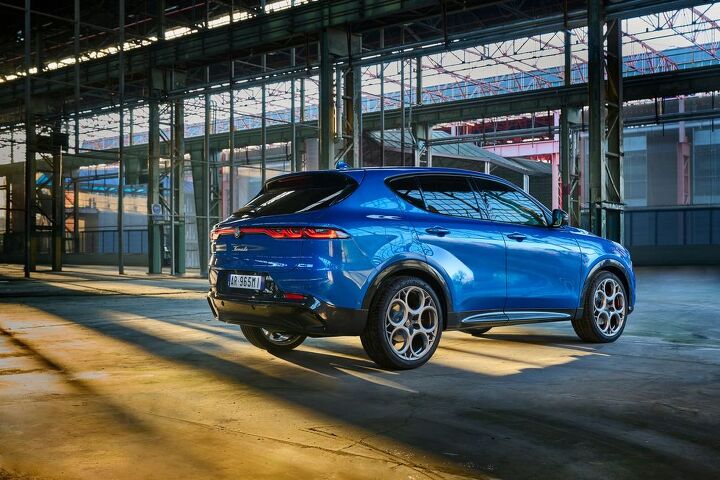2023 Alfa Romeo Tonale: Delayed But Drawing Nearer

Delayed by the semiconductor deficit, the 2023 Alfa Romeo Tonale is here and nearly ready for production.
It’s gone through some subtle changes since its 2019 debut at the Geneva Motor Show. But the Tonale, which I recently learned isn’t Italian for toenail, has remained true to the concept. The traditional Alfa grille has been retained while the razor-thin headlights have been widened slightly to make the signature LED elements more visible. But it’s otherwise indistinguishable from the concept without popping the hood or examining the non-fungible token (NFT) that comes with the car.
For whatever reason, Alfa Romeo opted to hop onto the NFT bandwagon after normal people got bored. Originally intended as the artistic offshoot of cryptocurrencies, NFTs enjoyed a frenzied interest during the pandemic. Then people started wondering why having the deed to a virtual piece of media (that can be easily replicated and needs to be hosted online somewhere just to exist) would be intrinsically valuable. But that didn’t stop celebrities from buying up the trendiest and most expensive examples before they end up on the wrong end of the Beanie Babies curve.
However, the NFT that comes with the Tonale isn’t totally useless. Alfa Romeo says that it exists as a digital certificate of authenticity that’s linked to the vehicle’s maintenance schedule. It also believes its very existence will help secure the vehicle’s residual value by having something to offer secondhand owners as proof the car wasn’t neglected. But that means you’ll need to have your automotive checkups done by Alfa-approved mechanics. Because none of the maintenance you do yourself will be recorded. Manufacturers discouraging people from using independent repair shops, or rolling up their sleeves and doing their own work, is nothing new. This method is just a bit more gimmicky than usual. There’s no real reason maintenance logs need to be in the form of an NFT and I’m sure the right-to-repair community will have something to say about the trend if it persists.
Phew. Now that the dumb stuff is out of the way, we can get into what the Tonale is really offering — a smaller (at 178.3 inches long), cheaper alternative to the Stelvio as well as the first Alfa Romeo to offer a plug-in hybrid powertrain.
Though interested parties don’t have to go with the hybrid. The 2023 Tonale will also be available with a turbocharged 2.0-liter inline-four (Europe gets a 1.5-liter) wed to a nine-speed automatic transmission. Exclusively all-wheel drive, the model is said to produce 256 horsepower and 295 pound-feet of torque.
But it’s the hybrid option that we saw previewed with the concept and it’s clearly the version Alfa is the proudest of. The PHEV setup pairs a turbocharged 180-hp, 1.3-liter inline-four, responsible for turning the front wheels, with a 121-hp electric motor that’s mounted on the rear axle. Combined, the AWD hybrid makes 272 hp and is capable of 0-to-60 mph blasts in 6.0 seconds. However, owners can use the 15.5-kWh lithium-ion battery pack to have the electric motor run solo for roughly 30 miles between charges.
The plug-in also offers a few unique driving modes. Natural is for everyday driving; Advanced Efficiency is designed electric-only driving, and Dynamic is supposed to squeeze the most out of the conjoined motors to maximize performance.
Alfa Romeo vowed that the crossover would boast athletic driving dynamics and, based on its other products, we’re inclined to believe them. The Tonale features a fully independent (MacPherson) suspension with optional adaptive dampers that can be softened up for the commute or firmed up for the race track. It also has a 13.6:1 steering ratio, which is fairly quick for a modern production vehicle but less swift than what’s offered on the Giulia Quadrifoglio.
The interior is typical Alfa Romeo. It will be better appointed than mass-market products but less plush than what you’d find if you walked over to browse the Maserati vehicles. Alfa still looks to be offering a luxurious interior, it’s just more interested in keeping occupants planted in the corners than ensuring their butts are pampered on the straights. A 10.25-inch Uconnect 5 infotainment system is standard (which is larger than the base unit found in the Stelvio) and works in tandem with a 12.3-inch digital cluster display designed to look like a vintage Alfa Romeo gauge cluster.
Default safety tech includes adaptive cruise control, lane-keep assist, and automatic emergency braking. But a traffic jam feature will be able to steer and moderate distance between you and the vehicle ahead in low-speed situations. Android Auto and Apple CarPlay are standard.
The Tonale will come in three trims (Sprint, Ti, and Veloce) with deliveries commencing in the first quarter of 2023. Those hoping to get one by that date will probably need to book one the second the option is available, which Alfa Romeo said wouldn’t happen until Q4 of 2022. Additional details about the car will be provided closer to launch but the one everyone seems most worried about is price. We’ve heard it’ll be just shy of $40,000 in the U.S., though nothing has been confirmed by the manufacturer.
[Images: Stellantis]

A staunch consumer advocate tracking industry trends and regulation. Before joining TTAC, Matt spent a decade working for marketing and research firms based in NYC. Clients included several of the world’s largest automakers, global tire brands, and aftermarket part suppliers. Dissatisfied with the corporate world and resentful of having to wear suits everyday, he pivoted to writing about cars. Since then, that man has become an ardent supporter of the right-to-repair movement, been interviewed on the auto industry by national radio broadcasts, driven more rental cars than anyone ever should, participated in amateur rallying events, and received the requisite minimum training as sanctioned by the SCCA. Handy with a wrench, Matt grew up surrounded by Detroit auto workers and managed to get a pizza delivery job before he was legally eligible. He later found himself driving box trucks through Manhattan, guaranteeing future sympathy for actual truckers. He continues to conduct research pertaining to the automotive sector as an independent contractor and has since moved back to his native Michigan, closer to where the cars are born. A contrarian, Matt claims to prefer understeer — stating that front and all-wheel drive vehicles cater best to his driving style.
More by Matt Posky
Latest Car Reviews
Read moreLatest Product Reviews
Read moreRecent Comments
- Carrera I live in Florida and owned summer tires once before on a Corolla. Yes I know, it's a Corolla but it drove much better ( to me) with those on. I would have bought them again but replacement time came during the beginning of the " transitory inflation" and by then, I found all seasons that were much cheaper. Currently I own a slightly more performance oriented Acura TLX -AWD and when the OEM all season Michelin wear out, I will replace them with summer Michelins. Often times, a car comes alive with summer tires but I understand why people don't buy them above South Carolina. I lived in Canada for 5 years and just thinking about swapping twice per year made me anxious.
- Steve Biro I don’t bother with dedicated summer or winter tires. I have no place to store them. But the newest all-weather tires (with the three-peak mountain symbol) are remarkably good year-round. The best of them offer 90 percent of the performance of winter tires and still fall mid-pack among summer ultra-high performance tires. That’s more than enough for my location in New Jersey.
- Carfan94 Never, it doesn’t get cold eneough here in TN, to switch to winter tires. But it gets cold enough that running Summer tires year round is impractical. I’m happy with my All seasons
- Analoggrotto Anyone who has spent more than 15 minutes around a mustang owner would know this will be in insta-hit.
- Akear If this is true then they won't go out of business. Good for them!






































Comments
Join the conversation
"optional addictive dampers" sound intriguing.
The proportions are really off on this one, looks like the platform has its limitations